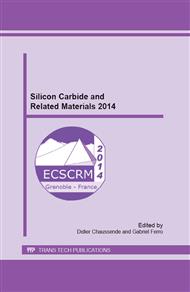p.444
p.448
p.452
p.456
p.460
p.464
p.468
p.472
p.476
Characterization of Inhomogeneity in SiO2 Films on 4H-SiC Epitaxial Substrate by a Combination of Fourier Transform Infrared Spectroscopy and Cathodoluminescence Spectroscopy
Abstract:
We measured Fourier transform infrared (FT-IR) and cathodoluminescence (CL) spectra of SiO2 films with various thicknesses, grown on 4H-SiC substrates. The appearance of broad phonon modes at ~1150–1250 cm-1 in p-polarized light and their disappearance in s-polarized light confirmed that the phonon modes at ~1150–1250 cm-1 originated from surface polaritons (SPPs). For the thin SiO2 film (8-nm thick), the peak frequency of the transverse optical (TO) phonon in the SiO2 film on the 4H-SiC substrate was observed at ~1080 cm-1 and was higher than that in SiO2 films on the Si substrate (1074 cm-1). This suggested that the thin SiO2 film (8-nm thick) is under compressive stresses at the interface between the SiO2 film and SiC substrate. On the other hand, for the thick SiO2 films (85 and 130-nm thick), the TO phonon peak frequency tended to shift toward lower frequencies with increasing oxide layer thickness. The CL measurement indicated that the CL peak intensity at ~640 nm, attributed to non-bridging oxidation hole centers (NBOHCs), became stronger with increasing oxide layer thickness, relative to that of the CL peaks at ~460 and 490 nm due to oxygen vacancy centers (OVCs). By comparing the FT-IR and CL measurements, we concluded that the TO phonon red-shift with increasing oxide layer thickness can mainly be attributed to an increase in inhomogeneity with increasing oxide layer thickness for the thick SiO2 films.
Info:
Periodical:
Pages:
460-463
Citation:
Online since:
June 2015
Price:
Сopyright:
© 2015 Trans Tech Publications Ltd. All Rights Reserved
Share:
Citation:


